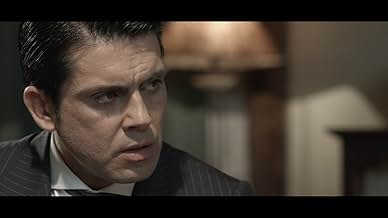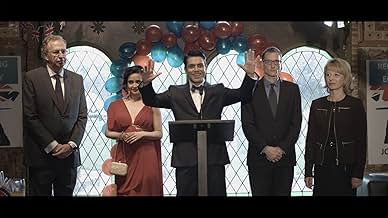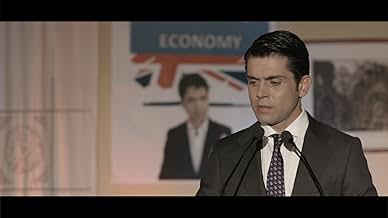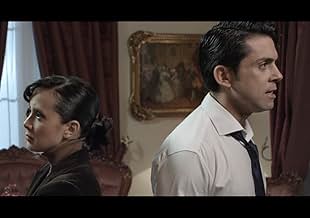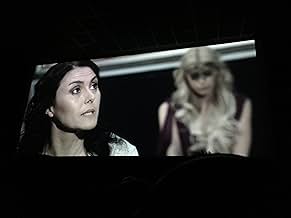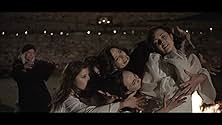अपनी भाषा में प्लॉट जोड़ेंNo force in the world as the force of desire Yerma. Inspired by the play of Federico García Lorca.No force in the world as the force of desire Yerma. Inspired by the play of Federico García Lorca.No force in the world as the force of desire Yerma. Inspired by the play of Federico García Lorca.
Mundy Rieu
- John Stone
- (as Mundy Rieu Jr.)
कहानी
फीचर्ड रिव्यू
'Yerma ' travels to London A film by Emilio Ruiz Barrachina brings Lorca's drama to the British capital.
In theory, Emilio Ruiz Barrachina's new film was portrayed as a bold work, potentially transgressing. The bits circulating on the Internet and some notices in the print media so predicted it. Which was not exactly a surprise for the connoisseurs who follow the trajectory of the always interesting filmmaker. This solid and growing group knows that room for the conventional in his work is minimal.
D a n n y F a u x Film critic Viewing the film, the expectations are confirmed From the beginning, the images and the music that accompany the title credits inform us unequivocally that the stakes are high. And its value increases notably, since on this occasion the director from Madrid tackles sacred material; nothing less than Yerma, the second part of the renowned Lorca Trilogy, published originally in 1934. There were two previous film versions of the distinguished play; one directed by Imre Gyongyos and Barna Kabay in the Hungarian-German-Canadian co-production of 1985; and the Spanish version directed by Pilar Távora in 1998. In a bold move, here Barrachina transfers the geographic and chronological action from the deepest lands of 1912 Andalusia to the English countryside and even to the heart of a great megalopolis, 21st Century London. As we will quickly see, such changes – apparently drastic – absolutely do not disturb the essence of the original play. Perhaps, they affirm with ingenuity the timeless constants and the universality of their profound significance.
One of the new variations brought to the script by Barrachina is presented by means of a parallel theatrical performance of Yerma in London which we follow through successive rehearsals. This innovation in the story can be perceived as a respectful "salute" to the origins of the play and, by extension as a sort of custodian of the aesthetic values of Hispanic culture. Cinematographically, numerous antecedents exist of film within film and theatre within film; but this time we have Yerma within Yerma. Although we have indicated the constant narrative audacity in Barrachina's film work, it should be noted that rarely – if ever – is it gratuitous. And it is never superficial. Possibly this version of Yerma is the best proof of this to date.
Aside from this, the director is a profound connoisseur of the life and work of Federico García Lorca. His exemplary documentary about Lorca, El Mar Deja De Moverse, received unanimous international critical acclaim. And also something perhaps even more significant: the explicit approval of the always meticulous Lorca clan. Likewise, the penchant for symbolism shared by Lorca and Barrachina is also well known. The transcendental sequence during which Eva submits herself to the fertility ritual – potentially prone to all sorts of excesses – is resolved in a controlled manner, if not economical. Barrachina distances himself from the facile use of effects (for a moment we can imagine, or perhaps not, this material in the hands of Ken Russell in his time, or in those of an inexperienced Brian De Palma.) With elegant visual efficiency the director achieves the difficult balance between the plastic-ally expressive , the suggestively poetic and the darkly supernatural: inherent and inseparable qualities of the quasi dreamlike nature of the scene.
Getting back to Yerma we must take a close look at the extraordinary work of Rebecca Grant in the role of the protagonist. Tour DE force is without a doubt a fairly trite term, but it is not easy to find an equivalent that does justice to the young British actress. The growing and unhealthy frustration of Eva, her character, as well as the progressive suspicion of deception on the part of her husband and the gradual revelation of her mental instability that Grant expresses in turn, is simply amazing. Yerma has found its best interpreter in this film. The shades of her internal emotional whirlwind are transmitted by Grant in such a natural form, that we literally are witness to a perfect symbiosis between the character and the actress. It's practically undetectable. Cinephiles of the world: be very attentive to future work by this actress.
American Susan Brickell in the role of The Old Lady also turns in an exceptional performance, with an appropriate economy of body language. Mundy Rieu gives credibility to the hermetic and distant character of John, Eva's husband. Francesc Pages is Victor, Eva's former professor and hidden romantic ideal. Special mention to María Ivanova as María, Eva's housemaid and confidante who clearly shows her interpretive talent. The role of Eva in the parallel theatrical presentation is played by the popular actress Miriam Diaz Aroca who appears as natural and expressive. The technical aspects of Yerma, photography, editing and continuity, are impeccable. Songs by the group Fausto Taranto – would you believe flamenco metal sounding – on the sound track are brilliantly appropriate to the film. Ominous sounds conjure and at the same time underline the atmosphere of tragic anticipation that lingers in our memory after the film has ended. Emilio Ruiz Barrachina's Yerma represents a clear example of what in music and film jargon is known as a sleeper. A "sleeper" waiting to wake up in form of a wide critical and audience recognition. Which belongs to it in its own right. A perfect encounter between the best of the modern and the best meaning of classicism.
In the beginning of the film the treatment of color is rather gloomy. Imperceptibly, the tonality takes on more darkness in accordance with the direction of the work and the destiny of its central character.
Pure Yerma Pure Lorca Pure Barrachina
In theory, Emilio Ruiz Barrachina's new film was portrayed as a bold work, potentially transgressing. The bits circulating on the Internet and some notices in the print media so predicted it. Which was not exactly a surprise for the connoisseurs who follow the trajectory of the always interesting filmmaker. This solid and growing group knows that room for the conventional in his work is minimal.
D a n n y F a u x Film critic Viewing the film, the expectations are confirmed From the beginning, the images and the music that accompany the title credits inform us unequivocally that the stakes are high. And its value increases notably, since on this occasion the director from Madrid tackles sacred material; nothing less than Yerma, the second part of the renowned Lorca Trilogy, published originally in 1934. There were two previous film versions of the distinguished play; one directed by Imre Gyongyos and Barna Kabay in the Hungarian-German-Canadian co-production of 1985; and the Spanish version directed by Pilar Távora in 1998. In a bold move, here Barrachina transfers the geographic and chronological action from the deepest lands of 1912 Andalusia to the English countryside and even to the heart of a great megalopolis, 21st Century London. As we will quickly see, such changes – apparently drastic – absolutely do not disturb the essence of the original play. Perhaps, they affirm with ingenuity the timeless constants and the universality of their profound significance.
One of the new variations brought to the script by Barrachina is presented by means of a parallel theatrical performance of Yerma in London which we follow through successive rehearsals. This innovation in the story can be perceived as a respectful "salute" to the origins of the play and, by extension as a sort of custodian of the aesthetic values of Hispanic culture. Cinematographically, numerous antecedents exist of film within film and theatre within film; but this time we have Yerma within Yerma. Although we have indicated the constant narrative audacity in Barrachina's film work, it should be noted that rarely – if ever – is it gratuitous. And it is never superficial. Possibly this version of Yerma is the best proof of this to date.
Aside from this, the director is a profound connoisseur of the life and work of Federico García Lorca. His exemplary documentary about Lorca, El Mar Deja De Moverse, received unanimous international critical acclaim. And also something perhaps even more significant: the explicit approval of the always meticulous Lorca clan. Likewise, the penchant for symbolism shared by Lorca and Barrachina is also well known. The transcendental sequence during which Eva submits herself to the fertility ritual – potentially prone to all sorts of excesses – is resolved in a controlled manner, if not economical. Barrachina distances himself from the facile use of effects (for a moment we can imagine, or perhaps not, this material in the hands of Ken Russell in his time, or in those of an inexperienced Brian De Palma.) With elegant visual efficiency the director achieves the difficult balance between the plastic-ally expressive , the suggestively poetic and the darkly supernatural: inherent and inseparable qualities of the quasi dreamlike nature of the scene.
Getting back to Yerma we must take a close look at the extraordinary work of Rebecca Grant in the role of the protagonist. Tour DE force is without a doubt a fairly trite term, but it is not easy to find an equivalent that does justice to the young British actress. The growing and unhealthy frustration of Eva, her character, as well as the progressive suspicion of deception on the part of her husband and the gradual revelation of her mental instability that Grant expresses in turn, is simply amazing. Yerma has found its best interpreter in this film. The shades of her internal emotional whirlwind are transmitted by Grant in such a natural form, that we literally are witness to a perfect symbiosis between the character and the actress. It's practically undetectable. Cinephiles of the world: be very attentive to future work by this actress.
American Susan Brickell in the role of The Old Lady also turns in an exceptional performance, with an appropriate economy of body language. Mundy Rieu gives credibility to the hermetic and distant character of John, Eva's husband. Francesc Pages is Victor, Eva's former professor and hidden romantic ideal. Special mention to María Ivanova as María, Eva's housemaid and confidante who clearly shows her interpretive talent. The role of Eva in the parallel theatrical presentation is played by the popular actress Miriam Diaz Aroca who appears as natural and expressive. The technical aspects of Yerma, photography, editing and continuity, are impeccable. Songs by the group Fausto Taranto – would you believe flamenco metal sounding – on the sound track are brilliantly appropriate to the film. Ominous sounds conjure and at the same time underline the atmosphere of tragic anticipation that lingers in our memory after the film has ended. Emilio Ruiz Barrachina's Yerma represents a clear example of what in music and film jargon is known as a sleeper. A "sleeper" waiting to wake up in form of a wide critical and audience recognition. Which belongs to it in its own right. A perfect encounter between the best of the modern and the best meaning of classicism.
In the beginning of the film the treatment of color is rather gloomy. Imperceptibly, the tonality takes on more darkness in accordance with the direction of the work and the destiny of its central character.
Pure Yerma Pure Lorca Pure Barrachina
टॉप पसंद
रेटिंग देने के लिए साइन-इन करें और वैयक्तिकृत सुझावों के लिए वॉचलिस्ट करें
विवरण
- चलने की अवधि1 घंटा 29 मिनट
- रंग
इस पेज में योगदान दें
किसी बदलाव का सुझाव दें या अनुपलब्ध कॉन्टेंट जोड़ें


